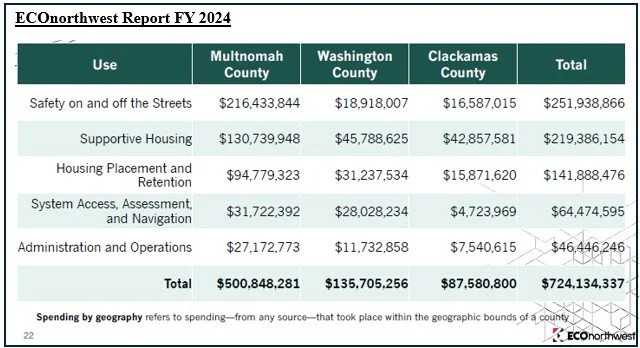Further Thoughts on the Spending on Homelessness in Multnomah County
A recent report by ECOnorthwest calculated that the 3-county Tri-County region (Multnomah, Washington, and Clackamas Counties) spent $724mm on homelessness in FY2024, of which $501mm was spent in Multnomah County.
However, the Portland Voice in its June Report said that spending in Multnomah County alone was $838mm.
Portland Voice Report, Multnomah County, FY 2024
Portland Solutions (city) $87,600,101
Joint Office of Homeless Services (county) $275,550,680
33% of Public Safety (city police, fire, 911) $182,436,758
Behav. Health, Substance Abuse Disorder, etc. (Medicaid, county, charity) $138,187,277
Emergency Room and Hospital (Medicaid, etc.) $154,222,642
Total Homeless Costs $837,997,458
Both studies used similar methodologies, so why is there such a large discrepancy? There are four major differences:
ECOnorthwest included Home Forward, Portland’s affordable housing agency, with a budget of approximately $140mm in its total, but Portland Voice did not. They argued that funding affordable housing helps prevent homelessness and, therefore, should be included in homelessness spending. While that is plausible, the money is not directly spent on the homeless, and there is no hard data on how many individuals in affordable housing would have become homeless. It is therefore impossible to tell if it is a cost-effective way to reduce homelessness, whatever its other merits. Therefore, Portland Voice did not include it in our totals.
Portland Voice included an estimate of the Behavioral Health (BH) spending, ECOnorthwest’s report does not. This is likely due to two factors. One is that the numbers are reported separately in the County Health Department’s budget, or are paid for by charity and/or Medicaid. Secondly is the “housing first” dogma, according to which putting the homeless into housing takes priority over treating their addictions and mental health problems. Portland Voice disagrees with that. We strongly believe that most of the homeless, particularly the “chronically homeless”, are not ready for housing, supported or otherwise, without first having their addictions and mental conditions stabilized. Therefore, BH spending is an important part of the homeless care continuum and needs to be counted--and prioritized.
Portland Voice included estimates of emergency room and hospitalization costs in the county, ECOnorthwest did not. We feel that these costs, while not budgeted for the homeless, are a direct burden on the citizens of the county. The hospitals compensate for the uncompensated care received by the homeless by raising the costs to other patients.
Portland Voice included a portion of the city’s Public Safety costs (police, fire, 911), ECOnorthwest, did not. Responding to calls related to the homeless account for over a third of police and fire department activities. This is a substantial strain on the city’s already understaffed and over-burdened budget, resulting in, among other things, extended delays in 911 response times, fewer resources for other investigations, and fire damage.
The ECOnorthwest report also tries to put our homelessness spending into context, comparing it to other cities. With their numbers, they show that in 2024 the Tri-County area spent $397/resident (not homeless people, but total residents) on homelessness, while New York City spent $474/resident. This implies that we are not overspending compared to others.
However, using the ECOnorthwest numbers for Multnomah County alone, you see total spending of $500,848,281. Divide that by 795,897 residents (US Census data), and one sees that Multnomah County spent $$629/resident, 33% more than New York City (which is a far more expensive place to offer any services).
But using the Portland Voice Multnomah County spending calculation of $837,997,458, you get $1,053/resident.
And if you add the $140mm of Home Forward spending to that, you get to total expenditure on the homeless of $978mm, or $1,229/resident.
And this does not even include the substantial private sector costs attributable to homelessness: security guards, replacing broken store windows, car break-ins, empty office buildings, business closures, and so on. These result in a lower quality of life and lower property values. Which, in turn, means lower tax revenues and fewer funds to pay for homeless services.
METHODOLOGY
For how ECOnorthwest compiled their numbers, please see pages 10 to 14 of their report. We feel their methodology was quite rigorous. However, as noted above, we feel that they omitted some significant systemic costs.
Portland Voice has fewer resources than ECOnorthwest, but we feel our numbers are reasonable. We calculated them as follows:
Spending by Portland Solutions (the City of Portland’s homeless services agency) is from the published FY 2024 budget.
Spending by Multnomah County’s Joint Office of Homeless Services is from their published FY 2024 budget.
Police and Fire homeless spending is one third of the city’s Public Safety Budget (includes 911). Anecdotally, somewhat more than that, about 35% to 40% of their time is spent responding to homeless calls and issues.
Behavioral Health, Addiction treatment: the total is based on the form 990’s of the major providers. We adjusted the totals based on estimates of how much of the total is spent in Multnomah County (vs surrounding counties), and how much (typically 50% to 67%) of their clients are homeless versus housed patients. These estimates are based on interviews with the providers.
For some clinics (Unity, SARA) for which 990’s are not available, we used the number of beds times $75K/year/bed.
Most of this money comes from Medicaid, some from private charity, and some from the county health department.
ER and Hospital Costs: Oregon Health Authority collects data on homeless ER and hospital discharges and average costs. They provided us with a spreadsheet showing that data for Multnomah County, which is available on request. Key data for 2024:
Homeless ER discharges, MultCo, 5,382, Avg cost $1,911
Homeless inpatient days, MultCo, 46,733, Avg cost/inpatient day $3,080
These numbers are based on codes entered during treatment. OHA notes that these are likely an undercount, especially for ER usage
Some of these costs are covered by Medicaid, a lot is absorbed by the hospitals and built into the rates charged to paying patients. i.e. to you and me.




